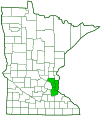rhubarb weevil
(Lixus concavus)
Conservation • Description • Habitat • Ecology • Distribution • Taxonomy
Conservation Status |
|
|||||||
| IUCN Red List | not listed |
|||||||
| NatureServe | NNR - Unranked |
|||||||
| Minnesota | not listed |
|||||||
Description |
||
Rhubarb weevil is a large, easily identified, true weevil. It is common from New Hampshire south to North Carolina, and west to Utah. It is uncommon in the upper Midwest, including Minnesota. The body is elongated, cylindrical, smooth, and black. At ⅜″ to ⅝″ in length and 3 ⁄16″ in width, it is one of the largest snout beetles in the United States. The thorax is composed of three segments. The first segment (prothorax) is large and prominent and appears to be the entire thorax. It is covered by a saddle-shaped plate (pronotum). The pronotum is slightly wider than long and is rounded at the sides. There are two pairs of wings, a membranous inner pair and a hardened outer pair (elytra). The elytra are attached to the second thoracic segment (mesothorax). They cover the mesothorax, the third thoracic segment (metathorax), and completely cover the abdomen. They are wider than the pronotum, oblong egg-shaped, narrowed toward the tips, moderately convex, longitudinally grooved, and pitted. There is a deep depression on the elytra and pronotum where they meet. The head is greatly elongated between the eyes and the mouth parts form a conspicuous snout. The snout is narrow, enlarged toward the tip, and very long, as long as the prothorax. It is projected forward and slightly bent downward. The antennae are short, slender, and elbowed. The last 3 segments are expanded and form a club. There are seven jointed segments between the base and the club. The first two segments are long, the second much longer than the first. The third through seventh segments are short. On the male the antennae are inserted one-fourth of the way from the tip of the snout. On the female they are longer and are inserted one-third of the way from the tip. The head, pronotum, and elytra are more or less dusted with a bright yellow or orange bloom. The bloom wears away easily, especially when the insect is handled. The third leg segment (femur) has a pale ring-like band and is armed with a small tooth on the inner side. The fourth leg segment (tibia) has a small hook on the inner side near the tip. |
||
Size |
||
Total length: ⅜″ to ⅝″ |
||
Similar Species |
||
| Dock curculio (Lixus mucidus) is the only other weevil known to attack rhubarb. It is very similar but the bloom is whitish, not yellowish, and the depression on the pronotum and elytra is not as deep. | ||
Habitat |
||
|
||
Ecology |
||
Season |
||
One generation per year: Mid-May to September |
||
Behavior |
||
|
||
Life Cycle |
||
Overwintering adults become active in mid-May. After mating, the female punctures the stem or crown of a host plant with her snout and feeds, creating a cavity. She then inserts a single egg about ⅛″ deep into the cavity. The egg hatches in 7 to 10 days. Several eggs may be laid in a single plant but only a single larva develops to maturity, suggesting that the larvae are cannibalistic. Up to 500 or more eggs may be laid in a season by a single female. Eggs laid in rhubarb do not hatch. The larva burrows down the stalk to the ground, chews an exit hole, and pupates within the stem after about 9 weeks. Adults emerge a few weeks later, in August and September. They overwinter in leaf litter. |
||
Larva Food |
||
Stalks of all of the adult’s host plants except rhubarb. |
||
Adult Food |
||
Stalks and leaves of thistle (Carduus and Cirsium), sunflower (Helianthus), dock (Rumex), and rhubarb (Rheum). |
||
Distribution |
||||
|
Sources |
|||
| 7/24/2022 | ||||
Occurrence |
||||
Not common in Minnesota |
||||
Taxonomy |
|||
Order |
Coleoptera (Beetles) | ||
Suborder |
Polyphaga (Water, Rove, Scarab, Long-horned, Leaf, and Snout Beetles) | ||
Infraorder |
Cucujiformia | ||
Superfamily |
Curculionoidea (snout and bark beetles) | ||
Family |
Curculionidae (true weevils) | ||
Subfamily |
Lixinae | ||
Tribe |
Lixini | ||
Genus |
Lixus | ||
Synonyms |
|||
Lixus coloradensis Lixus crassulus Lixus rectus Lixus soror |
|||
Common Names |
|||
rhubarb curculio rhubarb weevil |
|||
Curculio was the Latin name of the genus for all weevils in the 18th century. That genus now includes only nut weevils. The name has been adopted for common usage and is now another name for weevil. |
|||
Glossary
Elytra
The hardened or leathery forewings of beetles used to protect the fragile hindwings, which are used for flying. Singular: elytron.
Pronotum
The exoskeletal plate on the upper side of the first segment of the thorax of an insect.
Prothorax
The first (forward) segment of the thorax on an insect, bearing the first pair of legs but not wings.
Tibia
The fourth segment of an insect leg, after the femur and before the tarsus (foot).
Visitor Photos |
|||||
Share your photo of this insect. |
|||||
| This button not working for you? Simply email us at info@MinnesotaSeasons.com. Attach one or more photos and, if you like, a caption. |
|||||
Alfredo Colon |
|||||
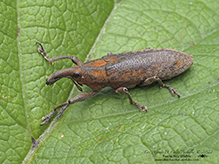 |
|||||
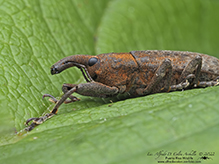 |
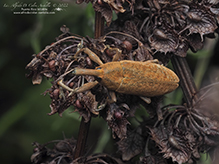 |
||||
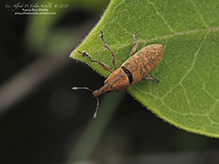 |
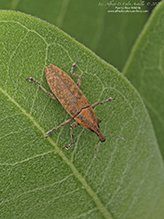 |
||||
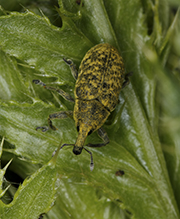 |
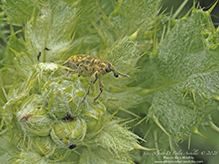 |
||||
MinnesotaSeasons.com Photos |
|||||
|
|||||

Slideshows |
||

Visitor Videos |
|||
Share your video of this mammal. |
|||
| This button not working for you? Simply email us at info@MinnesotaSeasons.com. Attach a video, a YouTube link, or a cloud storage link. |
|||
Other Videos |
|||


Created 7/18/2018
Last Updated:
